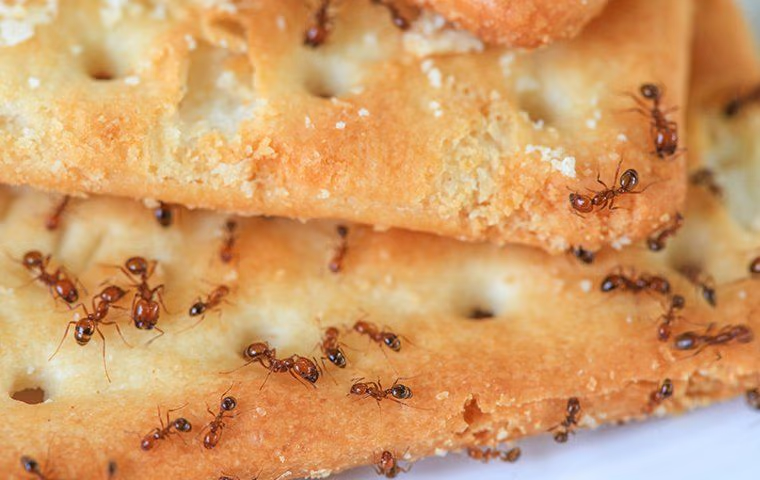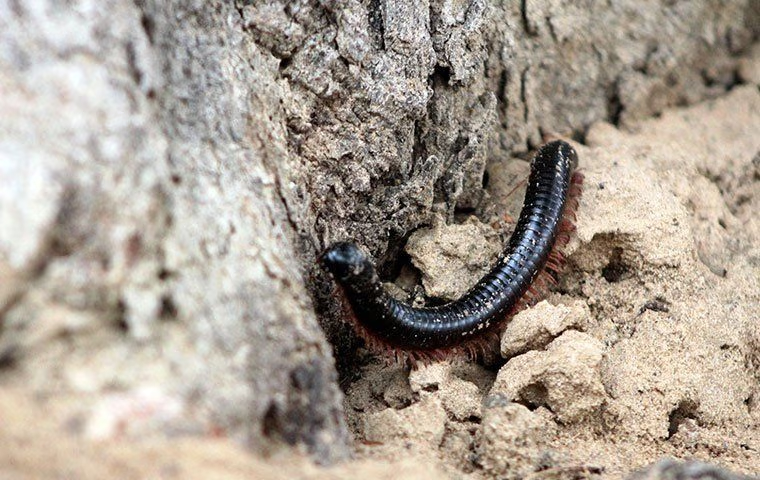Sugar ants get their common name because they are highly attracted to sugary substances. Sugar ants are also known as ghost ants.
Sugar ants are a tropical species introduced into the United States from Africa or Asia. Because ghost ants invade homes often and are well adapted to human habitats, they are considered a tramp species. Ghost ant colonies have multiple queens and can contain thousands of workers. In South Florida, sugar ants are the most common pest new clients call about for pest control services in South Florida.
What do sugar ants look like?
Sugar ants are very small; workers are monomorphic and measure about 1/16 inch long. The abdomen is whitish, while the head, thorax, legs, and antennae are dark colored. Because they are tiny and pale in color, sugar ants are hard to see on dark surfaces, which is where they get their common name, ghost ants.
Where do sugar ants nest?
Sugar ants can nest indoors or outdoors. Outside, they nest in cavities and voids near the ground: inside or underneath cracks in the foundation, dead trees, leaves or mulch, firewood piles, irrigation boxes, and the soil of potted plants. Sometimes foragers are seen trailing along the foundation or walls that lead to a window near the kitchen.
A common place where you find sugar ants is in the kitchen because they are attracted to sweets. Inside, they can nest in wall voids or cavities between the wall and cabinets or baseboards.
Occasionally, sugar ants are seen in bathrooms. Most of the time, they are looking for water, but sometimes they are attracted to common kinds of toothpaste containing sodium saccharine, which is a sweetener.
What do sugar ants eat?
In nature, sugar ants feed primarily on honeydew, but they also feed on dead and living insects. When workers are foraging, they move fast and erratically in various directions looking for food. Ghost ants prefer liquid foods, so they are highly attracted to jelly, syrup, and honey.
Once a food item is located, the worker will return to the nest while leaving a pheromone trail. A few minutes later, hundreds of sugar ants congregate around the food, and a single-file trail of ants develops from the nest to the food.
How to get rid of sugar ants?
A baiting program is one of the best methods to get rid of sugar ants. You should use only carbohydrate-based baits for ghost ants. When there is moderate to heavy ant infestation, it is best to complement the baits with a crack and crevice spray around the cabinets and baseboards using non-repellent insecticides.
The most popular gel bait for sugar ants is Terro. You can get it from any home improvement store. Ghost ants are highly attracted to Terro; however, the active ingredient in this bait is boric acid. Borates are effective and widely used in pest control treatments, but ants must feed for several days before the nest is eliminated. Pest management professionals have access to better baits made with neonicotinoids or oxadiazines that will quickly rid the ghost ants from your home.
No matter the species, every ant problem always originates outside. For long-term protection from sugar ants and other pests, it is best to spray the foundation with a non-repellent insecticide.
Natural ways to get rid of sugar ants
Unfortunately, there are no natural ways to get rid of sugar ants. They are a total waste of time and money! If this were true, pest control companies would be out of business.
Here are some of the DIY home remedies that are a total bust:
- Coffee grounds: it is widely believed that placing coffee grounds throughout the house will keep ants and other pests away. This myth is far from the truth, and you will probably stain some surfaces.
- Bay Leaves: sugar ants do not like bay leaves because there is no sugar. The syrup bottle next to the leaves is not immune to sugar ants.
- Pepper: every home has pepper in the pantry, and sugar ants do not care.
- Cinnamon: sprinkling cinnamon all over the kitchen. As with pepper, sugar ants are not bothered by this tactic. However, be prepared to make a big mess.
- Essential Oils: the strong odor of essential oils such as cinnamon, peppermint, and orange is a repellent for some pests. The instruction is to dilute a few drops in water and spray entry points and windowsills. The repellency effect only lasts for a few hours.
- White Vinegar: vinegar is known for its cleaning properties. When you use it to spray ant trails, you erase the pheromone trails. Sugar ants will take a detour around the sprayed areas and make new pheromone trails.
- Soap & Water: use soap and water to keep the house clean and deter ants from entering the home. You only kill very few ants with this method.
- Sealing Entry Points: sugar ants are very tiny; adults measure only 1/16 inch long. It is impossible to close every little gap and prevent them from getting inside.
None of these methods will permanently eliminate sugar ants from your home. Some are ineffective, and others will only give you temporary relief. You will have better luck preventing ghost ants from invading your home by having a clean house and cleaning spills than any of the above practices.
Effective DIY treatment for getting rid of sugar ants
The only DIY remedy we can recommend is making your own homemade bait using boric acid. Borates are used in many commercial-grade baits because they are an effective active ingredient, but it is a slow-acting poison. Boric acid is an inorganic compound that disrupts the energy production within the cells of insects.
Boric Acid is widely used in some pest control products because it is extremely safe for pets and children. When boric acid is mixed with a tasty food source, the foragers will ingest the active ingredient and carry it back to the colony and share it with every member via trophallaxis.
After several days or weeks, it is possible to eliminate sugar ants with this treatment. Be prepared to do lots of work because you have to do multiple placements and repeat as the bait dries up. Since sugar ants are sweet ants, the best food choice to mix boric acid into is sugar dissolved in water, jelly, syrup, or honey.
Why don’t over-the-counter sprays work on sugar ants?
The first thing people do when they see sugar ants on the counters is to grab a can of Raid or something similar. Initially, you feel very good because it seems to be working. This quick fix only lasts for a day or two, and then they are back!
The problem with sprays from big box stores is that they are contact-kill insecticides. The active ingredients in these products are neurotoxins that quickly kill the ants that come in contact with the spray. Since 10% of the colony is only foraging for food, you are only killing a few members. The queen and the vast majority of workers are safe in the nest producing more eggs.
Another issue with contact-kill insecticides is that they disrupt the pheromone trails that ants use to travel. When this happens, the ants will often split and form new colonies in other parts of the home. This process is known as budding, and it is common on tramp species that can have multiple queens per colony, such as sugar ants.
These materials are only repellents with no residual quality, so you are forced to use them repeatedly. In the long run, you will induce more budding and create exponentially more colonies.
How serious are sugar ants?
Sugar ants do not sting, and they do not cause structural damage. These tiny crawlers are harmless to humans. However, when left unchecked, the colonies can get out of hand and become a serious nuisance. Every sugary product in your pantry will be infested with ghost ants. At this point, it may be cheaper to hire an exterminator than to throw away some food items.
Ants are one of the primary food sources for spiders, especially the daddy long legs. Without controlling sugar ants, the spider population will thrive.
Do sugar ants bite?
Sugar ants have mouth parts that they use to defend their nest from invaders, so they are capable of biting. Foragers do not exhibit aggressive behavior like other ant species. Also, they have such a tiny jaw that you probably will never feel if they try to bite.
How to prevent sugar ants from returning?
Proper sanitation is one of the best ways to prevent sugar ants. Start by sweeping food crumbs from the floor, kitchen countertops, and sofa. Store sweet foods in tight seal containers and clean up spills. Do not leave dirty dishes overnight; remove leftover pet food from your dog or cat dish.
Inspect the exterior of your home for any plants or branches that may be touching the house. Ants can use this vegetation as highways to access your home and avoid the insecticide treatment around the foundation. Homeowners should trim any vegetation touching the structure, remove leaf litter or debris, and pick up rotten fruit around the house.
Ghost ants are highly attracted to the honeydew produced by plant-sucking insects such as aphids, mealybugs, and scales. A professional should treat any plants infested with these insects with a systemic insecticide.
When should I call an exterminator for sugar ants?
If you have tried to kill the sugar ants on your own, but you still see them, it is time to call a pest management professional. Once sugar ants are established indoors with multiple queens and multiple nests, it will only get worse.
For a long-lasting solution, it is best to hire a highly-rated exterminator like GOTBUGSIKILL. With our no pest guaranteed pest control program, KILL365, we will eliminate the sugar ants in as little as 24 hours.
Our eco-friendly treatments will protect your home and your family from many household-infesting pests. If you live near Palm Beach, Broward, and Miami-Dade, give us a call today for a free estimate and get started on our effective ant control services.
Nobody kills bugs better than GOTBUGSIKILL!

